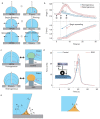Salvinia-like slippery surface with stable and mobile water/air contact line
- PMID: 34691630
- PMCID: PMC8288347
- DOI: 10.1093/nsr/nwaa153
Salvinia-like slippery surface with stable and mobile water/air contact line
Abstract
Superhydrophobic surfaces are widely used in many industrial settings, and mainly consist of rough solid protrusions that entrap air to minimize the liquid/solid area. The stability of the superhydrophobic state favors relatively small spacing between protrusions. However, this in turn increases the lateral adhesion force that retards the mobility of drops. Here we propose a novel approach that optimizes both properties simultaneously. Inspired by the hydrophobic leaves of Salvinia molesta and the slippery Nepenthes pitcher plants, we designed a Salvinia-like slippery surface (SSS) consisting of protrusions with slippery heads. We demonstrate that compared to a control surface, the SSS exhibits increased stability against pressure and impact, and enhanced lateral mobility of water drops as well as reduced hydrodynamic drag. We also systematically investigate the wetting dynamics on the SSS. With its easy fabrication and enhanced performance, we envision that SSS will be useful in a variety of fields in industry.
Keywords: Salvinia molesta; drag reduction; low adhesion; slippery Cassie state; stability.
© The Author(s) 2020. Published by Oxford University Press on behalf of China Science Publishing & Media Ltd.
Figures






Similar articles
-
Janus Fabric with Asymmetric Wettability for Switchable Emulsion Separation and Controllable Droplets with Low Friction.Langmuir. 2023 Jan 10. doi: 10.1021/acs.langmuir.2c03157. Online ahead of print. Langmuir. 2023. PMID: 36626239
-
Slippery Wenzel State.ACS Nano. 2015 Sep 22;9(9):9260-7. doi: 10.1021/acsnano.5b04151. Epub 2015 Aug 28. ACS Nano. 2015. PMID: 26302154
-
Fabrication of Salvinia-inspired surfaces for hydrodynamic drag reduction by capillary-force-induced clustering.Nat Commun. 2022 Sep 2;13(1):5181. doi: 10.1038/s41467-022-32919-4. Nat Commun. 2022. PMID: 36056031 Free PMC article.
-
Drop Friction and Failure on Superhydrophobic and Slippery Surfaces.ACS Nano. 2025 May 27;19(20):18902-18928. doi: 10.1021/acsnano.5c01142. Epub 2025 May 14. ACS Nano. 2025. PMID: 40367354 Free PMC article. Review.
-
Bioinspired super-antiwetting interfaces with special liquid-solid adhesion.Acc Chem Res. 2010 Mar 16;43(3):368-77. doi: 10.1021/ar900205g. Acc Chem Res. 2010. PMID: 19954162 Review.
Cited by
-
Kinetic drop friction.Nat Commun. 2023 Jul 29;14(1):4571. doi: 10.1038/s41467-023-40289-8. Nat Commun. 2023. PMID: 37516769 Free PMC article.
-
Anti-Environmental Aging Passive Daytime Radiative Cooling.Adv Sci (Weinh). 2024 Mar;11(10):e2305664. doi: 10.1002/advs.202305664. Epub 2023 Dec 26. Adv Sci (Weinh). 2024. PMID: 38148594 Free PMC article. Review.
-
An orthogonal dual-regulation strategy for sensitive biosensing applications.Natl Sci Rev. 2022 Mar 12;9(9):nwac048. doi: 10.1093/nsr/nwac048. eCollection 2022 Sep. Natl Sci Rev. 2022. PMID: 36285294 Free PMC article.
References
-
- Deng X, Mammen L, Butt HJet al. . Candle soot as a template for a transparent robust superamphiphobic coating. Science 2012; 335: 67–70. - PubMed
-
- Liu TL, Kim CJ. Turning a surface superrepellent even to completely wetting liquids. Science 2014; 346: 1096–100. - PubMed
-
- Quéré D. Wetting and roughness. Annu Rev Mater Sci 2008; 38: 71–99.
-
- Liu KS, Yao X, Jiang L. Recent developments in bio-inspired special wettability. Chem Soc Rev 2010; 39: 3240–55. - PubMed
-
- Bhushan B, Jung YC. Natural and biomimetic artificial surfaces for superhydrophobicity, self-cleaning, low adhesion, and drag reduction. Prog Mater Sci 2011; 56: 1–108.
LinkOut - more resources
Full Text Sources
